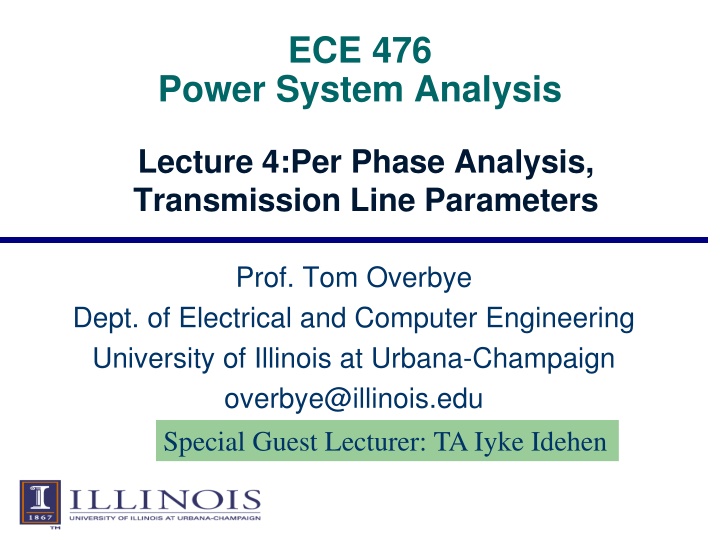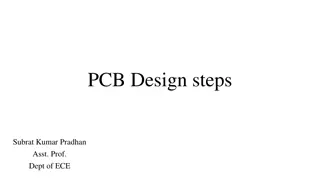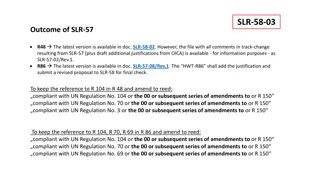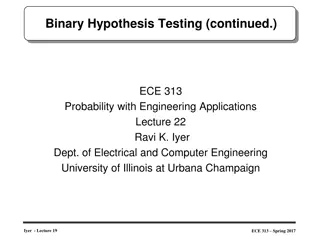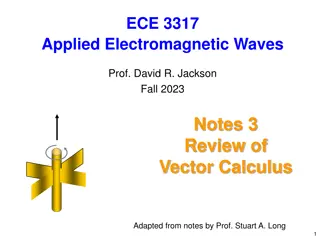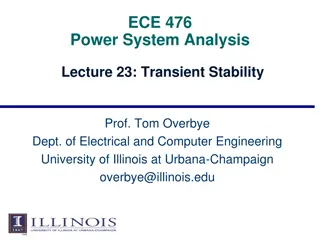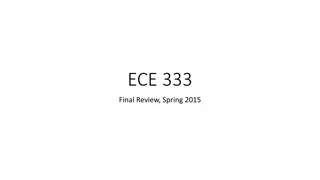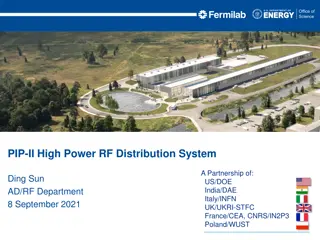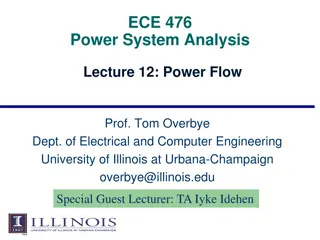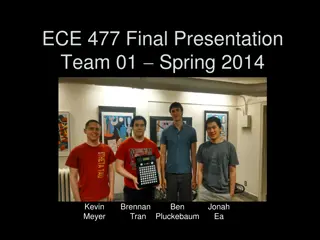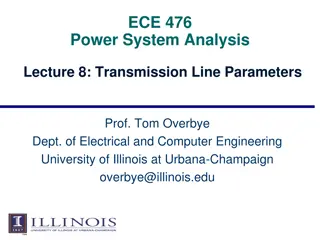ECE 476 Power System Analysis
This lecture covers the concept of per phase analysis in power systems, making it easier to analyze balanced three-phase systems. The balanced three-system theorem, analysis procedure, and example problems are discussed, providing a comprehensive understanding of this essential topic. Clear explanations and diagrams aid in grasping the intricacies of per phase analysis.
Download Presentation

Please find below an Image/Link to download the presentation.
The content on the website is provided AS IS for your information and personal use only. It may not be sold, licensed, or shared on other websites without obtaining consent from the author.If you encounter any issues during the download, it is possible that the publisher has removed the file from their server.
You are allowed to download the files provided on this website for personal or commercial use, subject to the condition that they are used lawfully. All files are the property of their respective owners.
The content on the website is provided AS IS for your information and personal use only. It may not be sold, licensed, or shared on other websites without obtaining consent from the author.
E N D
Presentation Transcript
ECE 476 Power System Analysis Lecture 4:Per Phase Analysis, Transmission Line Parameters Prof. Tom Overbye Dept. of Electrical and Computer Engineering University of Illinois at Urbana-Champaign overbye@illinois.edu Special Guest Lecturer: TA Iyke Idehen
Announcements Please read Chapters 4 and 5 HW 2 is 2.43, 2.47, 2.50, 2.52 It does not need to be turned in, but will be covered by an in-class quiz on Thursday Sept 8 1
Per Phase Analysis Per phase analysis allows analysis of balanced 3 systems with the same effort as for a single phase system Balanced 3 Theorem: For a balanced 3 system with All loads and sources Y connected No mutual Inductance between phases 2
Per Phase Analysis, contd Then All neutrals are at the same potential All phases are COMPLETELY decoupled All system values are the same sequence as sources. The sequence order we ve been using (phase b lags phase a and phase c lags phase a) is known as positive sequence; later in the course we ll discuss negative and zero sequence systems. 3
Per Phase Analysis Procedure To do per phase analysis 1. Convert all load/sources to equivalent Y s 2. Solve phase a independent of the other phases 3. Total system power S = 3 Va Ia* 4. If desired, phase b and c values can be determined by inspection (i.e., 120 degree phase shifts) 5. If necessary, go back to original circuit to determine line-line values or internal values. 4
Per Phase Example Assume a 3 , Y-connected generator with Van = 1 0 volts supplies a -connected load with Z = -j through a transmission line with impedance of j0.1 per phase. The load is also connected to a -connected generator with Va b = 1 0 through a second transmission line which also has an impedance of j0.1 per phase. Find 1. The load voltage Va b 2. The total power supplied by each generator, SY and S 5
Per Phase Example, contd First convert the delta load and source to equivalent Y values and draw just the "a" phase circuit 6
Per Phase Example, contd To solve the circuit, write the KCL equation at a' 1 ' ' ' 1 0)( 10 ) + + )( ) = (V V (3 ) (V j j j a a a 3 7
Per Phase Example, contd To solve the circuit, write the KCL equation at a' 1 ' ' ' 1 0)( 10 ) + + )( ) = (V V (3 ) (V j j j a a a 3 10 ' + 60 ) = + (10 V (10 3 10 ) j j j j a 3 ' ' = = V 0.9 volts V 0.9 volts a ' c b ' ab = = V 0.9 volts V 1.56 volts 8
Per Phase Example, contd * ' V V * = = = + a a S 3 3 5.1 3.5 VA a a V I V j ygen a 0.1 j * " ' V V " = = a a 3 5.1 4.7 VA S V j gen a 0.1 j 9
Development of Line Models Goals of this section are 1. develop a simple model for transmission lines 2. gain an intuitive feel for how the geometry of the transmission line affects the model parameters 10
Primary Methods for Power Transfer The most common methods for transfer of electric power are Overhead ac Underground ac Overhead dc Underground dc other 11
Magnetics Review Ampere s circuital law: = = H l F d I e F = mmf = magnetomtive force (amp-turns) = magnetic field intensity (amp-turns/meter) d = Vector differential path length (meters) l Algebraic sum of current linked by H l = Line integral about closed path (d is tangent to path) = I e 12
Line Integrals Line integrals are a generalization of traditional integration Integration along the x-axis Integration along a general path, which may be closed Ampere s law is most useful in cases of symmetry, such as with an infinitely long line 13
Magnetic Flux Density Magnetic fields are usually measured in terms of flux density B = flux density (Tesla [T] or Gauss [G]) (1T = 10,000G) For a linear a linear magnetic material = where is the called the permeability = = permeability of freespace = 4 = relative permea r bility B H 0 r -7 10 H m 0 1 for air 14
Magnetic Flux Total flux passing through a surface A is B a a = d A = vector with direction normal to the surface If flux density B is uniform and perpendicular to an area A then = BA d 15
Magnetic Fields from Single Wire Assume we have an infinitely long wire with current of 1000A. How much magnetic flux passes through a 1 meter square, located between 4 and 5 meters from the wire? Direction of H is given by the Right-hand Rule Easiest way to solve the problem is to take advantage of symmetry. For an integration path we ll choose a circle with a radius of x. 16
Two Conductor Line Inductance Key problem with the previous derivation is we assumed no return path for the current. Now consider the case of two wires, each carrying the same current I, but in opposite directions; assume the wires are separated by distance R. R To determine the inductance of each conductor we integrate as before. However now we get some field cancellation Creates a clockwise field Creates counter- clockwise field 17
Two Conductor Case, contd R R Rp Direction of integration Key Point: As we integrate for the left line, at distance 2R from the left line the net flux linked due to the Right line is zero! Use superposition to get total flux linkage. For distance Rp, greater than 2R, from left line Rp I I r Left Current Right Current Rp R 0 0 = ln ln left 2 ' 2 R 18
Two Conductor Inductance Simplifying (with equal and opposite currents) Rp I r Rp R 0 = ln ln left 2 ' R ( ) 0 = ln ' ln( r + ln ) ln I Rp Rp R R 2 R r R r Rp 0 = + ln ln I 2 ' Rp R 0 = ln as Rp I 2 ' R r 0 = ln H/m L left 2 ' 19
Many-Conductor Case Now assume we now have k conductors, each with current ik, arranged in some specified geometry. We d like to find flux linkages of each conductor. Each conductor s flux linkage, k, depends upon its own current and the current in all the other conductors. To derive 1we ll be integrating from conductor 1 (at origin) to the right along the x-axis. 20
Many-Conductor Case, contd Rk is the distance from con- ductor k to point c. We d like to integrate the flux crossing between b to c. But the flux crossing between a and c is easier to calculate and provides a very good approximation of 1k. Point a is at distance d1k from conductor k. At point b the net contribution to 1 from ik , 1k, is zero. 21
Many-Conductor Case, contd R d R r R d 0 1 ' 2 n = + + + ln ln ln 1 i i i 1 2 n 2 12 1 n 1 1 r 1 1 0 = + + + + ln ln ln 1 i i i 1 2 n ' 2 d d 12 1 n 1 0 + + + ln ln ln 1 i R i R i R 1 2 2 n n 2 = = As R goes to infinity R so the second n i = R R 1 1 2 n 0 term from above can be written =2 lnR 1 j 1 j 22
Many-Conductor Case, contd n = Therefore if 0, which is true in a balanced i j = 1 j three phase system, then the second term is zero and = + = + + 1 r 1 1 0 + + ln ln ln 1 i i i 1 2 n ' 2 d d 12 1 n 1 111 L i 12 2 L i L i 1 1 n n System has self and mutual inducta the mutual inductance can be canceled for balanced 3 systems with symmetry. nce. However 23
